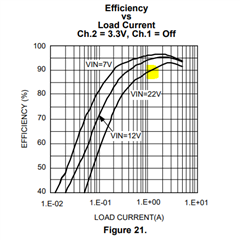Dear sirs,
We have some strange situation with this device - LM2642. We've done our own design based upon the one presented in datasheet with some modifications based on nominal values calculation of inductors, capasitors and loop compensation circuits. Our design is the following:
What we are doing:
At the input of board we connected a power source with stabilized output and ablility to set the ouput power. At the output 3.3 V side of board (2nd output) we have a load consists of serial and parallel connected resistors of 2.1 Ohm with appropriate nominal power (about 1,57 A). 5V output (1st output) is broken (see case 2 below) and doesn't consume any power.
Case 1:
What we want to see:
When we powering our scheme with power source of (1.57 * 3.3) = 5.18 W the input current is about 0.23 A (0.215 A for the load plus dozen of mA for efficiency).
What we actually see:

We measuring real current on 3.3 V load 1.33 A thus resulting the power of (1.33 * 3.3) = 4.39 W. Given input voltage equals 24.1 V (real measure) the input current is 0.21 A thus the power consumed from power source is actually 5.06 W. It equals that efficiency is about 87 %. I expected an efficiency of about 93-94 %. Were my expectations too optimistic?
Case 2:
Input power source is small enough to support such load current.
What we want to see:
Device should go into ULVO (Input Under-Voltage LockOut) and try to switch off external transistors to let the input voltage rise enough to return to normal mode.
What we actually see:
voltage at output diode:

in other scale:
and voltages input (blue) and VLIN (yellow):
Input voltage goes below 5 V and current limited to about 0,7 A.
We testing the 3.3 V output for now because the first ouput of the device (5 V) is broken. We have three devices LM2642 with broken first output for now under the same situations: as power input goes low (or load goes high enough), ULVO mode is on for some time (about 30s - 2m) and then 0V forever at this output not depending how much power we have at the input.
Questions for case 2 are: 1) Does input voltage (below 5 V) in ULVO mode appears to be normal? 2) Why does the first output fail after some time of ULVO mode?
Thank you!


